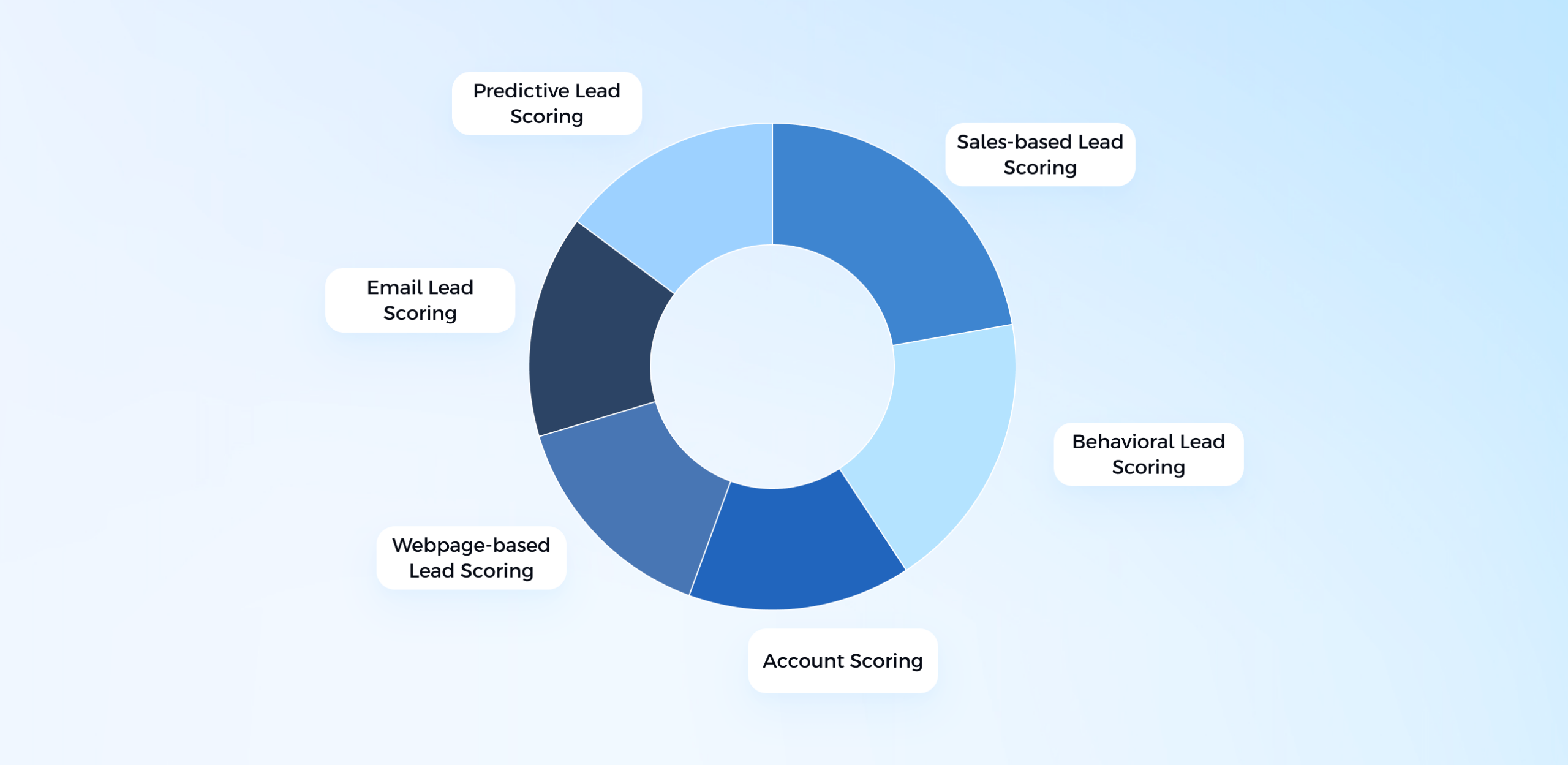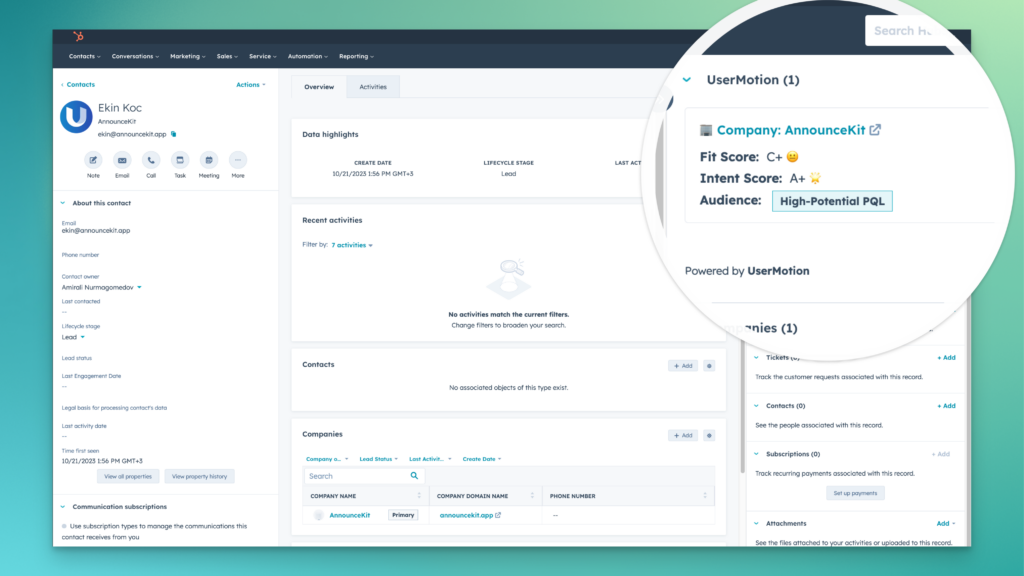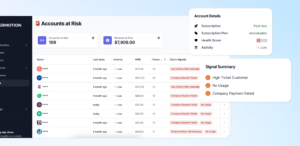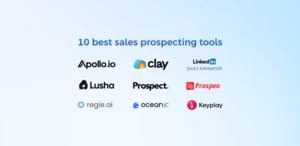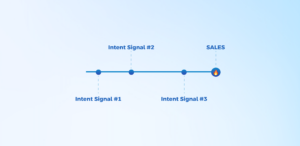You’ve understand the importance of lead scoring and now you are looking for some lead scoring examples? That’s exactly why we created a separate resource full of examples that can change how you prioritize your leads. There are multiple ways to qualify and score your leads, so you might evaluate all options to find which way suits your needs.
If you are new and want to start from scratch, you can visit our previous resources in order:
- What is lead scoring?
- Why you should use lead scoring?
- Lead scoring criteria
- Lead scoring tools
- Lead scoring template
- And here you are!
10 Lead Scoring Examples
1. Sales-based Lead Scoring
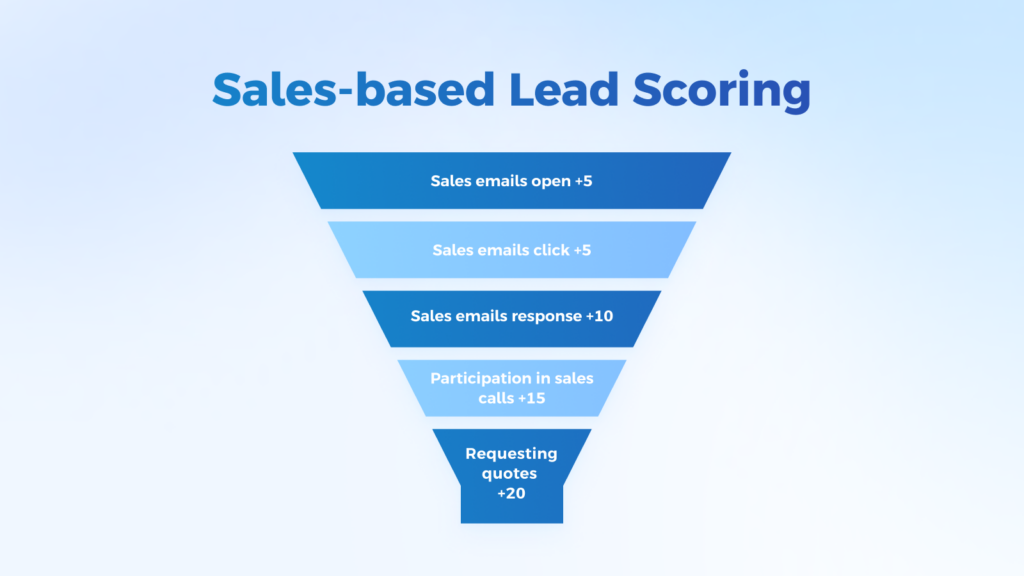
Sales-based lead scoring means assigning scores to leads based on their direct interactions with the sales and personal comments from the team.
In this method, the sales team scores leads manually based on the information and data they collect, like responding to sales emails, participating in sales calls or meetings, and requesting quotes or demos are scored.
This method directly reflects the sales team’s scores into lead’s interest and engagement level with the sales process.
Metrics and Signals
- Sales emails open rate
- Sales emails click rate
- Sales emails response rate
- Participation in sales calls or meetings
- Requesting quotes
- Requesting demos
Best for
This method is best suited for the sales-led or enterprise-level companies, which relies heavily on custom pricing, custom contracts and long and multi-step sales processes.
2. Email Lead Scoring
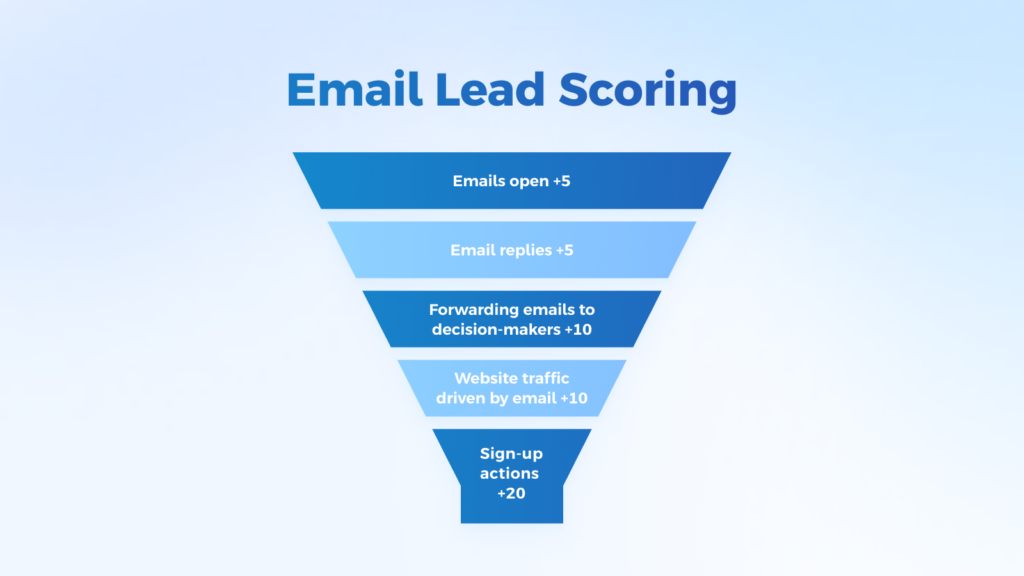
Email lead scoring focuses on measuring a lead’s interest and engagement through their interaction with email marketing campaigns. Leads score higher when they are actively engaged with emails, indicating a strong interest in the brand or product offerings.
Metrics and Signals
- Open rates
- Click-through rates
- Email replies
- Email bounce rate
- Forwarding emails (to decision-makers)
- Download actions
- Website traffic driven by email
- Sign-up actions
- Engagement over time
- Segmentation effectiveness
Best for
This method is particularly effective for businesses that engage in content and email marketing or rely on nurturing leads through informative and sales email sequences. It is suitable for both B2B and B2C companies which prioritize email marketing, including tech, software as a service, and other digital services.
3. Demographic and Firmographic Lead Scoring
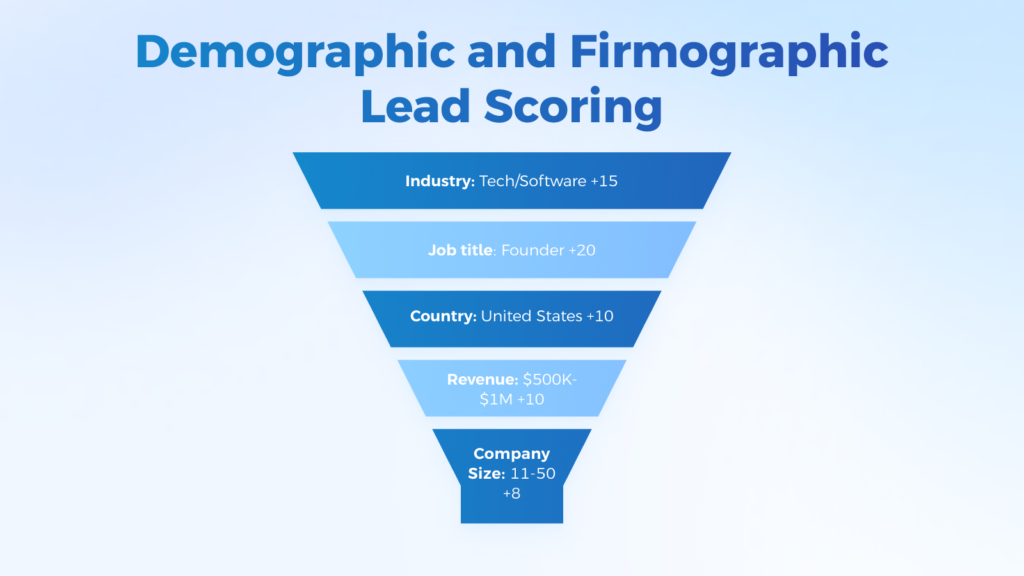
Demographic and firmographic lead scoring involves assessing leads based on demographic information for individuals (such as age, gender, income, education, and occupation) and firmographic data for businesses (such as industry, company size, location, and revenue).
To implement this effectively, you need accurate and comprehensive data about your leads. Company enrichment services streamline this process by providing up-to-date information.
This approach helps in identifying leads that best fit the ideal customer profile (ICP) for both B2C and B2B. Scoring criteria are set based on how closely leads match the characteristics of successful customers, enabling targeted and personalized marketing and sales efforts.
Metrics and Signals
- Industry
- Revenue
- Country
- Company Age
- Company Size
- Type of Business
- Investment
- Geography/Target Market
- Headquarters Location
- Tech Stack
- Company Work Style
- Job Title
- Job Role
- Role in Buying Process
- Tech Stack
- Field of Expertise
The important point here is to assign a point value to each criterion based on its significance towards indicating a lead’s likelihood to convert. For example, Industry (Tech/Software: 15 points, Manufacturing: 10 points) or Job title (Founder: 20 points, Manager: 10 points).
Best for
Best for all kind of companies from startups to scaled, that have defined a specific ICP for different business operations. But this method in particular is ideal for companies with marketing strategies that require personalized messaging, sales efforts aimed at high-value target markets, and segmentation and targeting in marketing campaigns.
4. Behavioral Lead Scoring (newly called Product-led Lead Scoring)
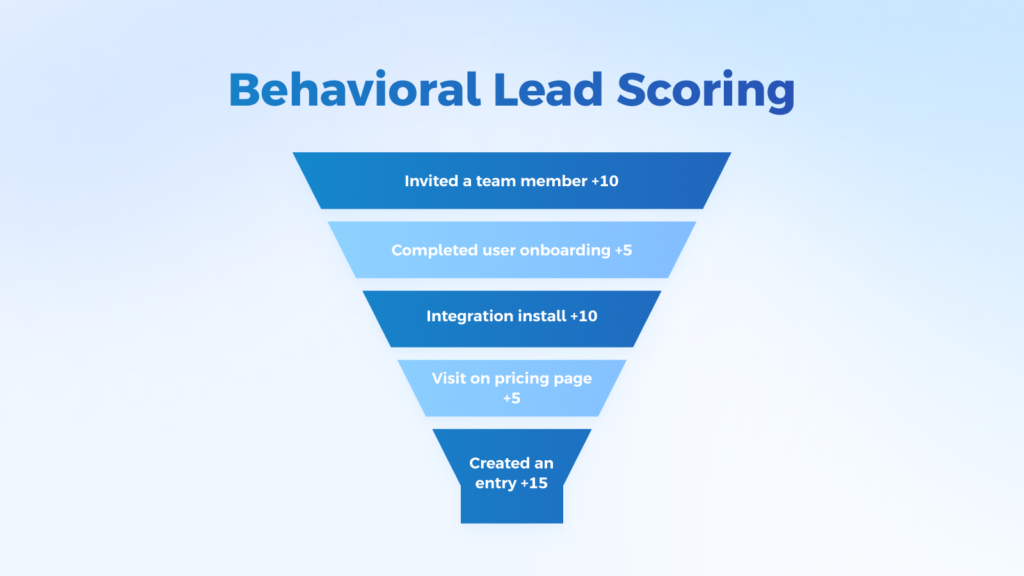
This is one of the best ways to centralize customer and lead behavior in scoring. This way, leads are scored based on their behavior and interactions with the brand across various channels.
It includes all app interactions, key events, website visits, content downloads and social media interactions. Behavioral scoring helps to understand a lead’s level of interest and stage in the buying process, allowing for personalized follow-up actions.
Metrics and Signals
- Invited a team member
- Completed user onboarding
- Integration install
- Created an entry
- Visit on pricing page
- Visit on documentation
- Visit on legal pages
- Visit on blog
- Multiple webpage visits
- Contact support through chatbot
- Email open, click or forward
- Socail media engagement
Best for
This method is ideal for B2B technology and SaaS companies that require active user engagement and education across multiple touchpoints. It fits businesses with complex products or services, where customer onboarding, integration, and support are key to success.
Suitable for businesses emphasizing personalized customer journeys and interactions, it helps identify engaged leads for targeted follow-ups in scenarios involving customized solutions and intricate sales processes.
5. Account-based Lead Scoring
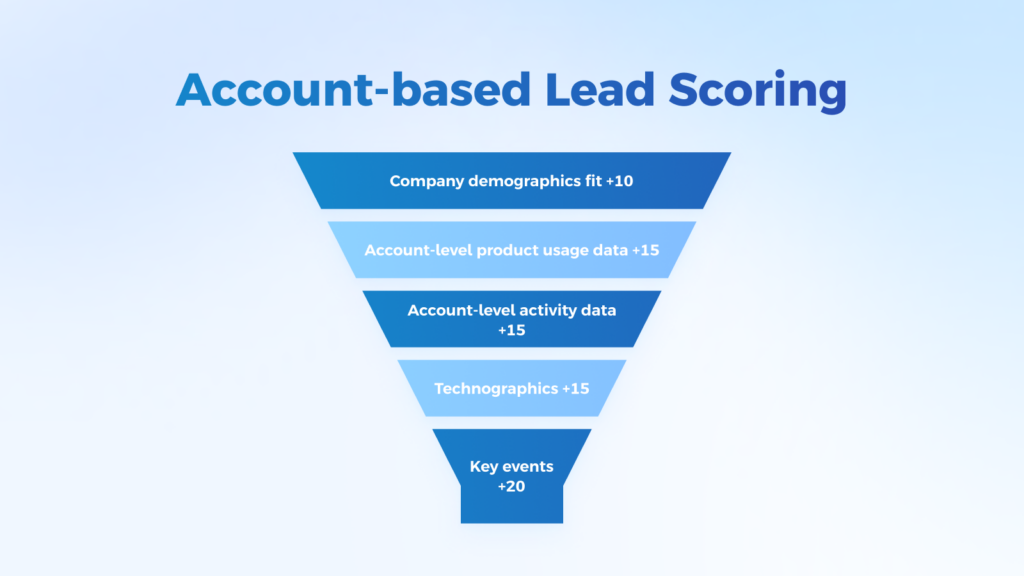
In B2B marketing, account scoring evaluates the potential of entire organizations rather than individual leads. It considers factors like company size, market potential, budget, and strategic alignment. Account scoring is crucial for account-based marketing strategies, focusing efforts on high-value organizations.
Metrics and Signals
- Company demographics and all related information
- Account-level product usage data
- Account-level engagement data
- Account-level activity data
- Account health score
- Key events
- Technographics
- Account growth potential
Best for
This scoring model is most suitable for product-led B2B companies that embrace free trial and freemium models. It’s ideal for organizations focusing on maximizing product adoption and expansion within existing accounts, leveraging direct user engagement and feedback to inform sales strategies.
6. Content-based Lead Scoring
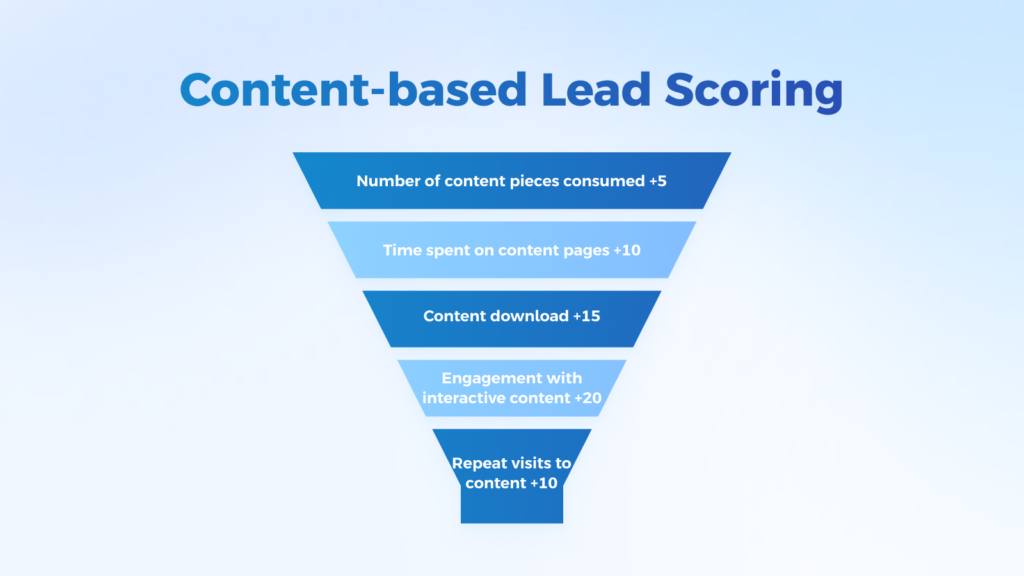
This method assigns scores to leads based on their interaction with specific content types, such as blog posts, whitepapers, case studies, or videos. Engaging with content that is deeper in the funnel, like product comparisons or case studies, scores higher, indicating a serious buying intent.
Metrics and Signals
- Number of content pieces consumed
- Type of content consumed (e.g., blog posts, whitepapers, case studies, videos)
- Time spent on content pages
- Content download frequency
- Engagement with interactive content (e.g., quizzes, calculators)
- Repeat visits to content pages
- Shares of content on social media
- Comments or feedback on content
- Completion rate of video content
- Engagement with product comparison and pricing pages
- Content visitor to customer rate
Best for
This scoring model is most suitable for businesses leveraging content marketing to nurture leads through the sales funnel. It’s ideal for companies across B2B and B2C sectors that produce a variety of content types aimed at educating, engaging, and converting their audience.
7. Social Media-based Lead Scoring
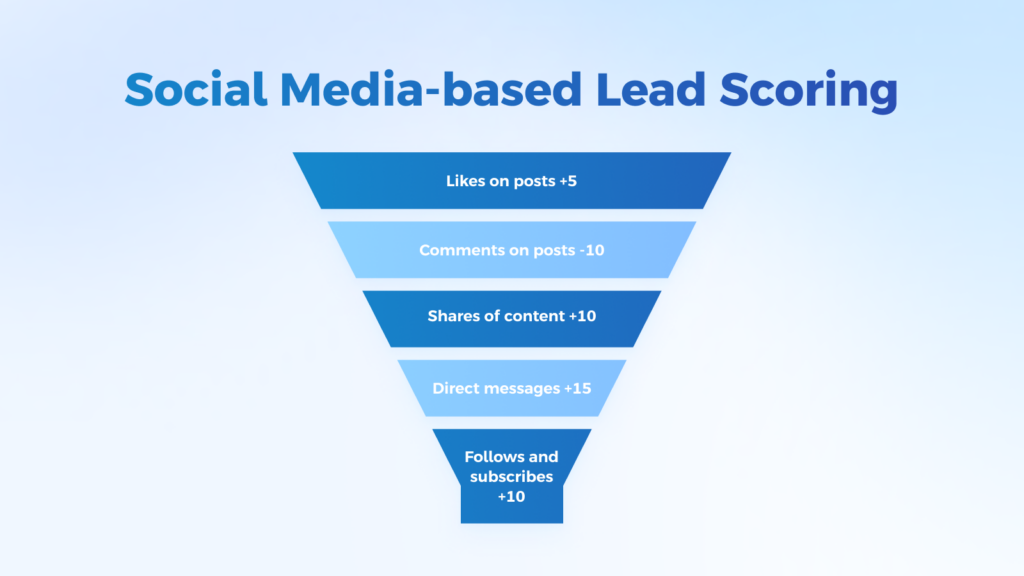
In this lead scoring example, leads are scored based on their engagement with a brand’s social media content, including likes, comments, shares, and direct messages. Active engagement on social media platforms indicates a lead’s interest and their willingness to interact with the brand publicly.
Metrics and Signals
- Likes on posts
- Comments on posts
- Shares of content
- Direct messages to the brand
- Engagement with specific campaign hashtags
- Follows and subscribes
- Participation in polls and surveys
- Click-throughs from social media links
- Mention or tags of the brand
- Engagement rate by platform
Best for
This scoring model is highly effective for brands with a strong social media presence and those looking to leverage social interactions for lead generation and brand engagement. It’s particularly well-suited for B2C companies aiming to deepen customer relationships and for B2B organizations seeking to enhance their brand visibility and engagement within professional communities.
8. Webpage-based Lead Scoring
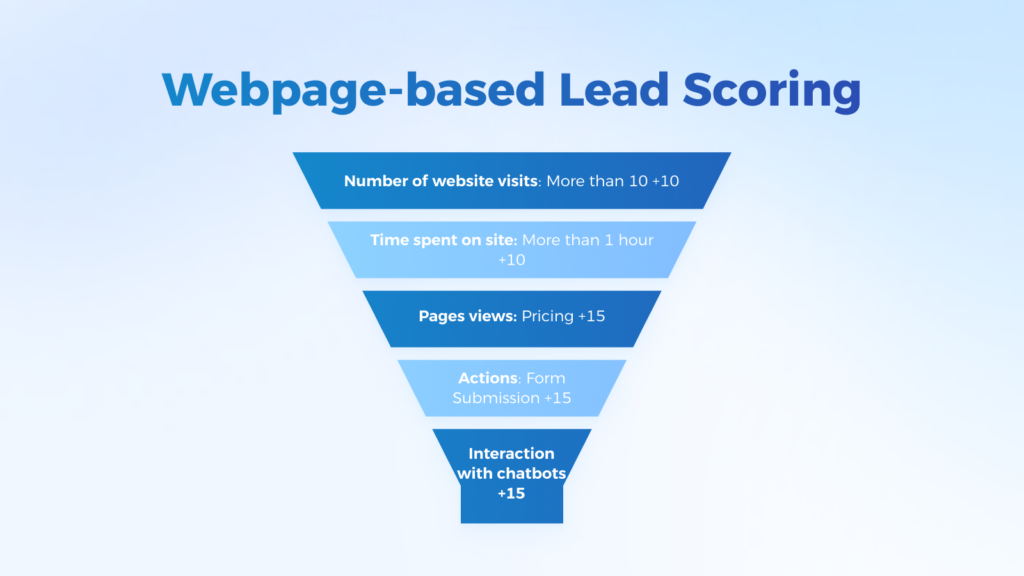
This strategy scores leads based on their interaction with the company’s website. Key metrics include the number of visits, specific pages viewed (such as pricing or product pages), and the time spent on the site. High engagement levels on critical pages suggest a deeper interest in the offerings.
Metrics and Signals
- Number of website visits
- Time spent on site
- Pages viewed, especially pricing, product, or service pages
- Actions taken (e.g., form submissions, downloads)
- Frequency of visits
- Bounce rate on key pages
- Interaction with chatbots or contact forms
- Use of search functionality on the site
- Repeat visits to specific content or product pages
- Engagement with FAQs or support sections
Best for
This scoring model is particularly beneficial for businesses aiming to optimize their online presence and convert website traffic into qualified leads. It’s well-suited for both B2B and B2C companies that rely on their website as a primary tool for information dissemination, lead capture, and sales conversions.
9. Event-based Lead Scoring
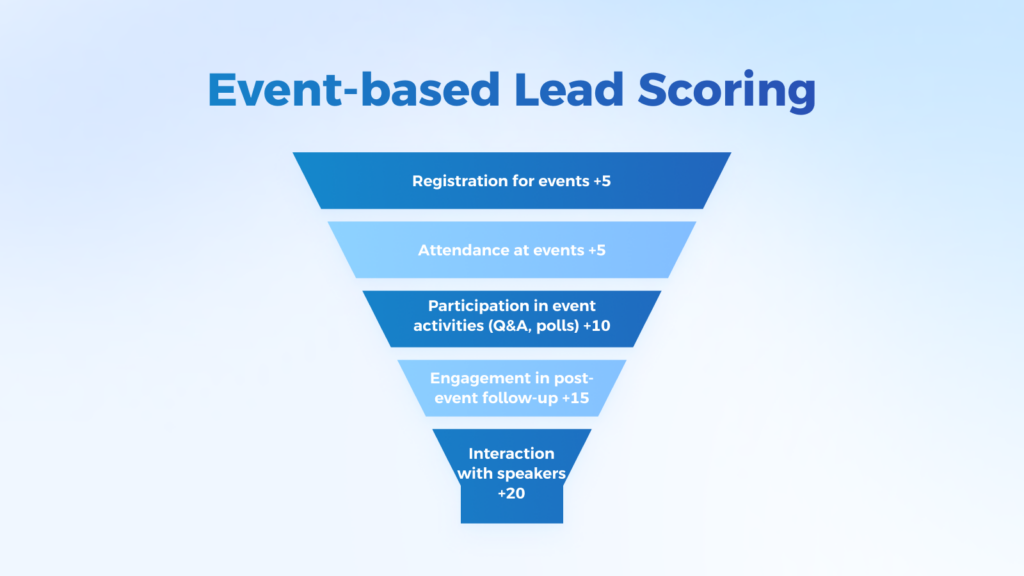
Participation in events such as webinars, workshops, trade shows, or conferences is scored. Actions like registering, attending, and engaging during the event are considered. Active event participation often indicates a high level of interest in learning more about the products or services offered.
Metrics and Signals
- Registration for events
- Attendance at events
- Participation in event activities (Q&A, polls)
- Engagement in post-event follow-up
- Duration of attendance in webinars or virtual events
- Downloading event materials
- Interaction with speakers or brand representatives
- Social media engagement related to the event
- Feedback provided on event surveys
Best for
This scoring model is particularly effective for companies that host or participate in events as a key part of their marketing and sales strategy. It’s well-suited for B2B companies looking to establish thought leadership and deepen engagement with potential leads in a niche market.
10. Predictive Lead Scoring
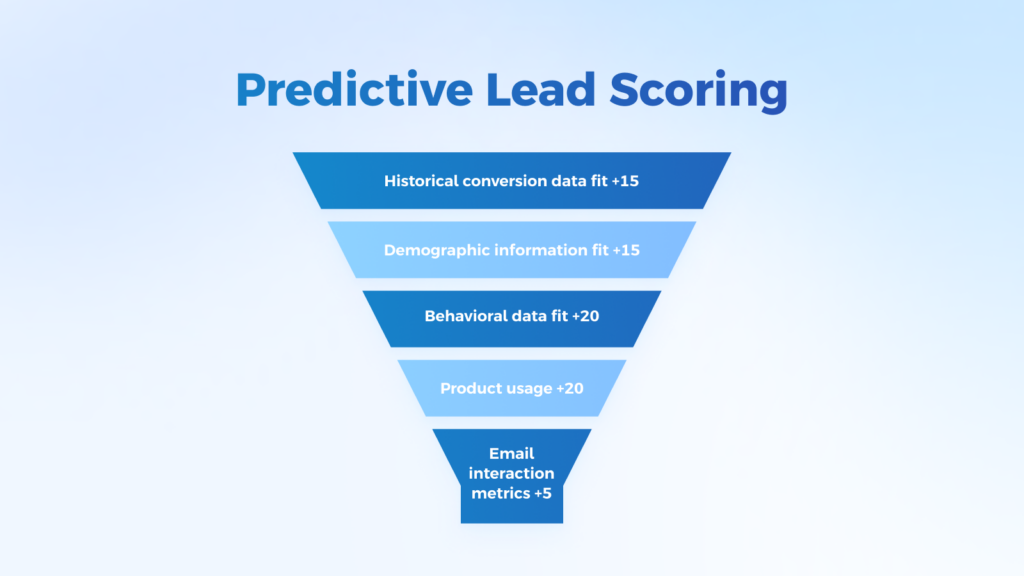
Now it comes to the part where we highly recommend to use. Using machine learning and artificial intelligence, predictive lead scoring analyzes historical data to forecast a lead’s likelihood to convert.
It combines multiple data points – including demographic, behavioral and engagement data and all other lead scoring examples – based on specific business needs to create a score. This method adapts over time and becomes more accurate as more data is collected.
Metrics and Signals
- Historical conversion data
- Demographic information of leads
- Behavioral data (website visits, content engagement)
- Email interaction metrics (open, click-through rates)
- Social media engagement levels
- Event participation details
- Account-based metrics for B2B
- Product usage data for SaaS companies
- Customer feedback and survey responses
- Lead response time to marketing or sales contacts
Best for
This scoring model is best suited for companies of all sizes and industries looking to drive advanced analytics for lead prioritization and sales productivity. It is especially useful for companies with access to extensive historical lead and customer data, enabling them to leverage AI for predictive insights.
Ideal for B2B, it allows for dynamic scoring that adjusts as more data becomes available, making it a powerful tool for refining marketing strategies and improving conversion rates over time.
UserMotion: Predictive Lead Scoring
Of all lead scoring examples, the one that stands out is predictive lead scoring with its ability to improve and refine over time. Historical data is golden and I am disappointed when I see companies not using it.
Traditional scoring methods can be effective in very focused strategies, but often fall short in assessing other key metrics and signals together to qualify your leads.
This is where UserMotion comes in and offers a modern solution for predictive lead scoring that takes the pain out of the process.
Self-Learning Algorithms for Accurate Scoring
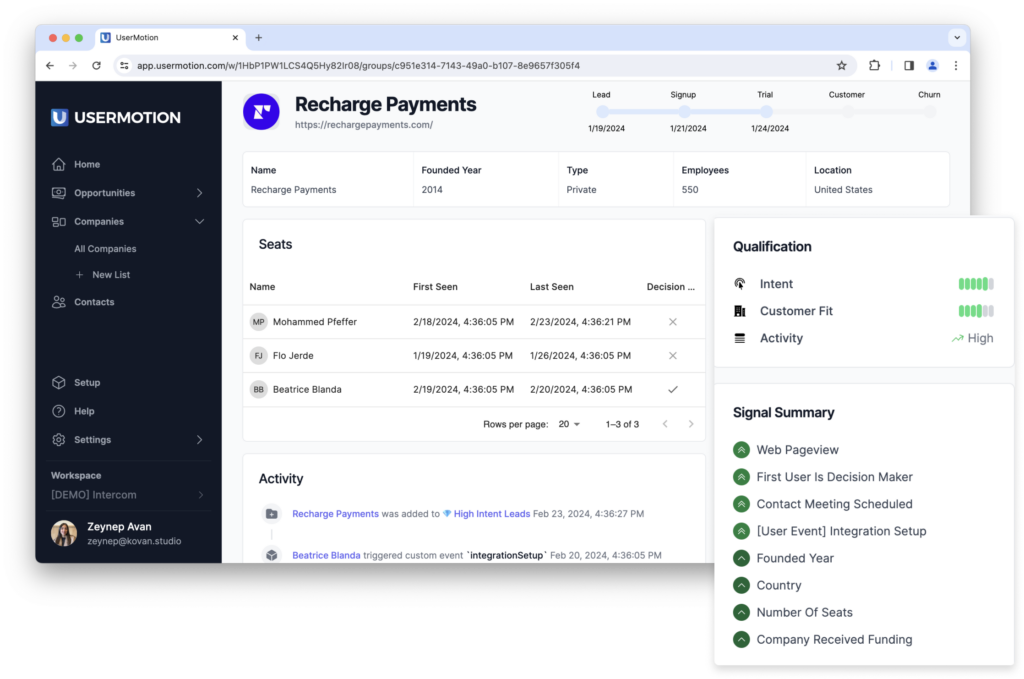
At the heart of UserMotion’s offering is its self-learning predictive scoring algorithm. This system continuously refines its scoring model based on user behavior, ensuring that your lead scoring evolves alongside your business.
By automatically adjusting to new data and criteria, UserMotion provides an always-accurate view of which leads hold the most potential, and which might be losing interest.

Effortless Implementation and Integration
UserMotion is known for being easy to use. It’s different from traditional methods that often need a lot of work with spreadsheets or special skills to work with CRM systems like HubSpot, Close, or Stripe. UserMotion makes starting simple.
Its friendly platform lets businesses get started quickly without getting stuck on technical details, helping them focus on making big decisions instead of dealing with small problems.
Clear Prioritization and Segmentation
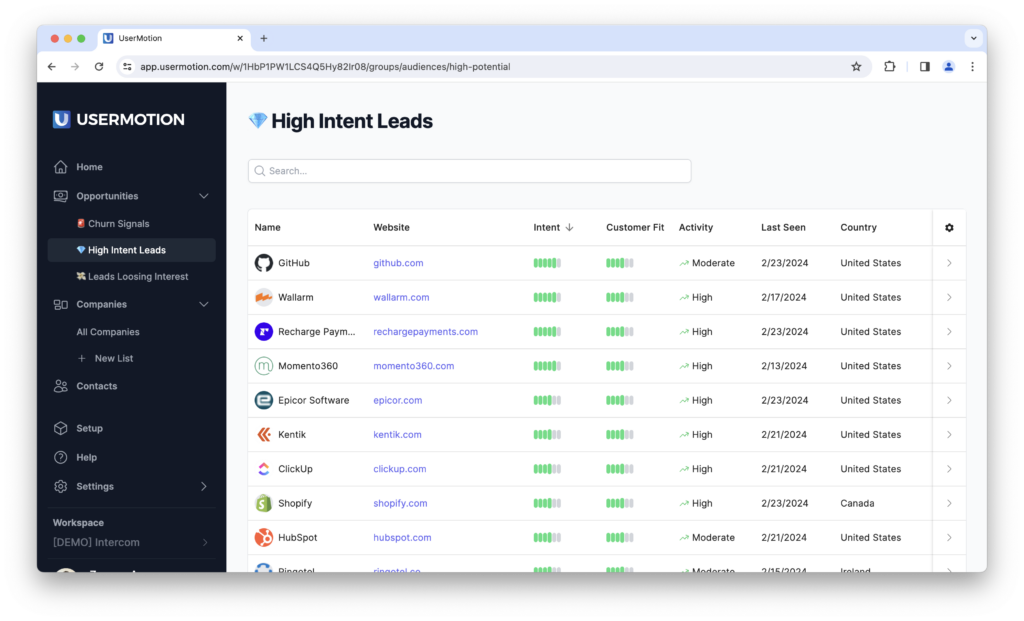
UserMotion doesn’t just score leads; it’s great at sorting and segmenting them in a way that you can use right away.
Whether you want to pay attention to leads with a lot of potentials, find out which leads might churn, or look for new chances to make money, UserMotion’s smart system sorts and segment your leads for you.
This sorted list isn’t just a way to be more efficient; it’s a guide to help you focus your efforts where they will do the most good.
A Tool for Every Team
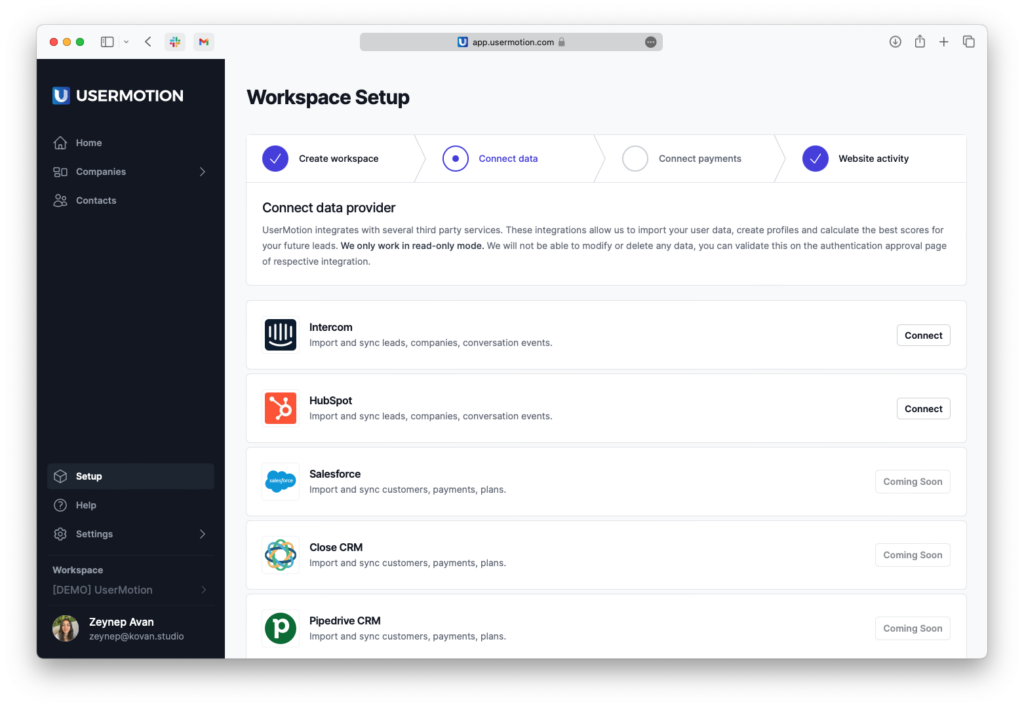
What really makes UserMotion stand out is how everyone can use it. It’s made for teams with any level of skill, so whether you’ve been in sales for years or are just starting in marketing, you can use its advanced scoring features.
Being able to easily work with popular sales tools means UserMotion can smoothly become a part of how you already work, making your lead scoring better without getting in the way of your normal tasks.
Choose Your Lead Scoring Model
Understanding the importance of lead scoring is the first step, and you’re on the right path if you’re exploring different lead scoring examples to find the best fit for your business.
It’s crucial to assess all options to ensure your chosen method aligns perfectly with your needs. Whether you’re starting from scratch or looking to refine your existing process, consider the following 10 lead scoring models:
- Sales-based Lead Scoring: Direct interactions with the sales team inform this score.
- Email Lead Scoring: Focuses on engagement with email campaigns.
- Demographic and Firmographic Lead Scoring: Uses individual or company information to score leads.
- Behavioral Lead Scoring: Scores based on interactions across various channels.
- Account Scoring: Evaluates the potential of entire organizations.
- Content-based Lead Scoring: Assesses interaction with various types of content.
- Social Media-based Lead Scoring: Scores leads based on social media engagement.
- Webpage-based Lead Scoring: Uses website interactions to score leads.
- Event-based Lead Scoring: Considers participation in events.
- Predictive Lead Scoring: Leverages AI and machine learning to forecast lead conversion likelihood.
if your business is navigating through the complexities of lead scoring and seeking an efficient, accurate way to prioritize leads, UserMotion’s predictive lead scoring model aligns perfectly with your needs.
Frequently Asked Questions
Lead scoring is more than a strategy, is a part of sales, marketing and revenue growth to qualify and prioritize leads based on different traits thought different methods like sales-based lead scoring, account-level lead scoring, content-based lead scoring or predictive lead scoring.
Here are some lead scoring tools for different business needs and requirements, both traditional and product-led:
1. Hubspot
2. Drift
3. Madkudu
4. UserMotion
5. 6sense
6. Pocus
7. Breadcrumbs
8. Oufunnel
9. ActiveCampaign
10. Forwrd
The components of lead scoring may vary according to different business focuses and strategies, but can be generally considered as follows:
1. Sales objectives
2. Marketing objectives
3. Behavioral scoring/intent level
4. Demographics/customer fit
5. Firmographics
6. Account level scoring
7. Email scoring
8. Positive effects
7. Negative effects
8. Assigning weight to each criteria
9. Historical data
10. Predictive scoring

